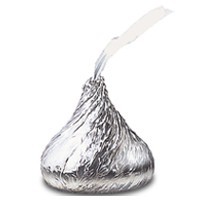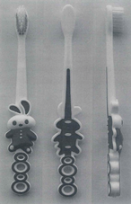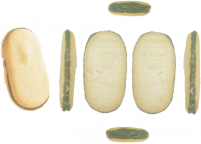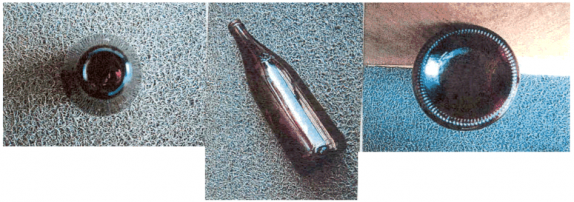Trademarks formed by shapes of the products and of their packaging: Registration requirements and absolute prohibitions stated in the Peruvian law and administrative case law.

Published byClaudia Valdivia

1. Introduction
Decision 486, Common Regime on Industrial Property – hereinafter Decision 486 – establishes trademark registration requirements in its Article 134 and trademark registration prohibitions in its Articles 135 (absolute registration prohibitions), 136 and 137 (relative registration prohibitions).
As a consequence, to obtain the registration of a trademark in Peru, this must (i) comply with the registration requirements applicable to all trademarks and (ii) not fall within the absolute and relative registration prohibitions applicable according to the type of trademark in question.
Decision 486 also establishes which signs are registrable as trademarks.
Among said signs are the shapes of the products and the shapes of the packaging or wrappings of the products, as set forth in Article 134, clause f) of Decision 486.
This document will be dealing with the following matters concerning the trademarks formed by the shapes of the products and the shapes of the packaging of the products, namely: (i) the registration requirements and (ii) the absolute registration prohibition referred to usual shapes, as stated in Article 135, clause c) of Decision 486.
2. Registration requirements applicable to trademarks formed by the shapes of the products and of their packaging
As clearly inferred from Article 134 of Decision 486, the requirements for registration as trademarks of the shapes of the products and the shapes of packaging of the products are those applicable to all types of trademarks, that is: susceptible of graphic representation and distinctiveness.
In Doctrine, the trademarks formed by the shape of the products or shape of the packaging of the products are called three-dimensional or plastic trademarks.
The Specialized Division of INDECOPI’s Intellectual Property Court (second administrative instance authority) – hereinafter the Court – states that “the Court –making reference to the Andean Community Justice Court – understands that, according to Doctrine, a three-dimensional trademark is such formed by particular shapes of the packaging, containers, wrappings or other arrangement of the products or by the shape thereof.” (Resolution Nº 4678-2016/TPI-INDECOPI of December 12, 2016, p.6)
In the Court’s opinion, in order that the shapes of the products and the shapes of the products’ packaging be registered as trademarks they must be distinctive, that is they must have any characteristic that makes them uncommon and unusual (Resolution No. 1297-2008/TPI-INDECOPI of June 03, 2008, page 5; Resolution No. 0818-2014/TPI-INDECOPI of May 12, 2014, page 5; Resolution No. 826-2019/TPI-INDECOPI of May 15, 2019, page 9).
An example of a three-dimensional trademark formed by the shape of the product is the shape of chocolate KISSES owned by The Hershey Company: 
An example of a three-dimensional trademark formed by the shape of the product’s packaging is the bottle COCA-COLA CLASSIC of the soft drink COCA COLA, owned by The Coca-Cola Company:
1. Absolute registration prohibitions applicable to trademarks formed by the shape of the products and of their packaging
From Article 135 of Decision 486 (absolute registration prohibitions) as well as from the administrative caselaw, it is understood that the absolute registration prohibitions applicable to trademarks formed by the shapes of the product and the shapes of the products’ packaging are the following:
- Article 135, clause b) of Decision 486, applicable to all types of trademarks, establishes that it cannot be registered as trademarks the signs lacking distinctiveness.
- Article 135, clause c) of Decision 486, applicable only to three-dimensional trademarks, establishes that it cannot be registered as trademarks the signs exclusively formed by usual shapes of the products and of their packaging, or formed by the shapes or characteristics dictated by the nature or the particular function of the product or service in question.
- Article 135, clause d) of Decision 486, also applicable only to three-dimensional trademarks, establishes that it cannot be registered as trademarks the signs that are exclusively formed by shapes or other elements that attribute a functional or technical advantage to the product or service to which they are applied.
2. Absolute registration prohibition established in Article 135, clause c) of Decision 486
The Court believes that the basis of this registration prohibition lies in that the granting of an exclusive right on usual shapes of a type of products or of their packaging, would limit competitors from the possibility of using necessary and essential presentation shapes and/or packaging thereof; thus, access to the market would be blocked for competitors of this type of products. (INDECOPI. Caselaw Summary Intellectual Property Court (1996-1999). Volume I, page 62. Resolution No. 4678-2016/TPI-INDECOPI of December 12, 2016, page 7. Resolution No. 0891-2019/TPI-INDECOPI of May 23, 2019, page 23)
The Andean Community Justice Court establishes that this registration prohibition involves the following four suppositions:
- First supposition: usual shapes of the products.
- Second supposition: usual shapes of the packaging or wrappings of the products.
- Third supposition: shapes or characteristics dictated by the nature or the function of the product or service.
- Fourth supposition: shapes or characteristics dictated by the nature or the function of the packaging or wrapping of the product or service.
(Pre-Judicial Interpretation of August 24, 2015 issued in Proceeding 242-IP-2015, page 32 at http://comunidadandina.org)
As mentioned in the introductory part, the first and second suppositions will be developed below, according to which it is prohibited the registration as trademarks of:
- usual shapes of the products and
- usual shapes of the packaging or wrappings of the products.
3. Absolute registration prohibition established in Article 135 clause c) of Decision 486: First supposition: usual shapes of the products
Article 135, clause c) of Decision 486 in its first supposition prohibits the registration as trademarks of usual shapes of the products.
The Court mentions that usual shapes of products relate to the common presentation shapes of such products, which do not include particular and arbitrary representations of the products. (Resolution No. 2621-2011/TPI-INDECOPI of November 21, 2011, page 18; Resolution No. 4678-2016/TPI-INDECOPI of December 12, 2016, page 6; Resolution No. 0891-2019/TPI-INDECOPI of May 23, 2019, page 22-23).
The concept of usual shape of the product mentioned by the Court corresponds to the same concept established by the Andean Community Justice Court. (Pre-Judicial Interpretation of October 05, 2003 issued in Proceeding 84-IP-2003, cited in the Pre-Judicial Interpretation of March 05, 2008 issued in Proceeding 195-IP-2007, cited at the same time in Pre-Judicial Interpretation of August 24, 2015 issued in Proceeding 242-IP-2015, page 32 at http://comunidadandina.org).
6. Registration absolute prohibition established in Article 135 paragraph c) of Decision 486 : second supposition : usual shapes of the packaging of the products
Article 135 paragraph c) of Decision 486, in its second supposition, prohibits the registration as trademarks of usual shapes of the packaging of the products.
The Court states that the usual shapes of the packaging of the products relate to the habitual presentation shapes of the packaging of the products and do not comprise peculiar and arbitrary representations of the packaging of the products. (Resolution No. 2621-2011/TPI-INDECOPI of November 21, 2011, page 18. Resolution No. 4678-2016/TPI-INDECOPI of December 12, 2016, page 6. Resolution No. 0891-2019/TPI-INDECOPI of May 23, 2019, pages 22-23)
The Court of Justice of the Andean Community states that “packaging means any container for containing liquid, gaseous products or those that not having in their natural state a fixed or stable shape, acquire the shape of the container, o even those other products that due to their size, shape or nature cannot be offered directly to the public.” (Pre-judicial Interpretation dated August 24, 2015, issued in Proceeding 242-IP-2015, page 33. At http://comunidadandina.org)
Said Court further states that “in the packaging concept can include a wide range, such as bottles, containers, boxes, cases, figures, cans, wrappings, and everything that has volume characteristics or provide a configuration that is not the simple and plain of the two-dimensional trademarks” (Pre-Judicial Interpretation of August 24, 2015, issued in Proceeding 242-IP-2015, page 33. At http://comunidadandina.org)
We notice that, although Article 135 paragraph c) of Decision 486 states that shall not be registered as trademarks the marks that consist exclusively of “usual shapes of the goods or their packaging”, as indicated in point 3 hereof, the Court of Justice of the Andean Community when interpreting Article 135 paragraph c) of Decision 486 states that the second supposition of this article is the “usual shapes of the packaging or wrapping of the products”, as indicated in point 4 hereof, and, Article 134 of Decision 486 states that may be registered as trademarks “the shape of the products, their packaging or wrappings”, as indicated in point 1 hereof.
Given the different use of the terms “packaging”, “wrapping” and “wrapper” in our legislation and caselaw mentioned in the above paragraph, we consider necessary to take into account the definitions of said terms, with the purpose of correctly applying the second supposition of the registration prohibition established in Article 135 paragraph c) of Decision 486.
For this purpose, we will refer to the definitions of these terms in the Diccionario de la Lengua Española, which we cite below:
- “packaging
3. (…) That which wraps or contains articles of commerce or other stock for preserving or transporting them.” (REAL ACADEMIA ESPAÑOLA. Diccionario de la Lengua Española. At https://www.rae.es)
- “wrapping
2. (…) wrapper (…).” (REAL ACADEMIA ESPAÑOLA. Diccionario de la Lengua Española. At https://www.rae.es)
- “wrapper
1. (…) Outer layer that covers naturally or artificially a thing.
(…)” (REAL ACADEMIA ESPAÑOLA. Diccionario de la Lengua Española. At https://www.rae.es)
Based on these definitions, we are of the opinion that that term “packaging” mentioned in Article 135 paragraph c) of Decision 486 includes (i) the term “wrapping” mentioned by the Court of Justice of the Andean Community in its interpretation of said article and (ii) the term “wrapper” mentioned in Article 134 paragraph f) of Decision 486.
7. Administrative caselaw
In the following administrative caselaw, the Trademark Office (first administrative instance) and the Court (second administrative instance) have issued opinion on the three-dimensional trademark and the application of the first and second suppositions of Article 135 paragraph c) of Decision 486.
7. Administrative caselaw
In the following administrative caselaw, the Trademark Office (first administrative instance) and the Court (second administrative instance) have issued opinion on the three-dimensional trademark and the application of the first and second suppositions of Article 135 paragraph c) of Decision 486.
7.1. Caselaw regarding the three-dimensional trademark concept
-
Resolution No. 3281-2016/TPI-INDECOPI of September 7, 2016, issued by the Court, in connection with File Nº 603644-2015, which confirms Resolution No. 1535-2015/CSD-INDECOPI, which declares groundless the nullity action, filed against trademark (FIGURA 3 – BORRAR)
, which distinguishes products in class 11, for considering, among other arguments, that Article 135 paragraph c) of Decision 486 was not applicable, since the trademark object of nullity was not a three-dimensional trademark and said article is referred only to trademarks of three-dimensional nature.
-
Resolution No. 0755-2019/TPI-INDECOPI of April 9, 2019, issued by the Court, which confirms Resolution No. 5805-2018/CSD-INDECOPI, which declares groundless the nullity action filed against trademark (FIGURA 4 – BORRAR)
, which distinguishes products in class 16, for considering, among other arguments, that Article 135 paragraph c) of Decision 486 was not applicable, since the trademark object of nullity has two-dimensional composite character and not three-dimensional character.
7.2. Caselaws regarding usual shape of the product
Resolution No. 826-2019/TPI-INDECOPI of May 15, 2019, issued by the Court, in connection with File No. 755572-2018, which grants the registration of trademark
, to distinguish “toothbrushes and floss for dental purposes” in class 21, for considering that: “(…) from the verification on the web pages of the establishments that sell this type of products, (…), it is noticed that it is not common using toothbrushes with handles in the form of stylized figure of a rabbit with four holes at the bottom part. In this sense, the applied-for three-dimensional mark, presents a toothbrush shape which handle has the stylized figure of a rabbit and four holes at the bottom part; presenting characteristics that sufficiently differ it from similar products within the market; so it allows being associated with a concrete business origin.” Resolution No. 0818-2014/TPI-INDECOPI of May 12, 2014, issued by the Court in File No. 501989-2012, which confirms Resolution No. 6176-2013/CSD-INDECOPI of April 26, 2013, which denies the registration of trademark
, to distinguish “cookies and crackers, sponge cakes and biscuits” in class 30, for considering that “from the analysis of the applied-for mark it is noticed that the latter presents the usual shape of some of the products it intends to distinguish, that is, biscuits, not being sufficient including a protuberance in the upper part of the biscuit, nor the chocolate filling amidst the same, to provide it with sufficient distinctiveness to obtain registration, (…)”. 7.3. Case law regarding the usual shape of the product packaging Resolution No. 2015-2005/OSD-INDECOPI of February 16, 2005, issued by the Trademark Office in connection with File No. 195126-2003, which denies the registration of trademark
, to distinguish “exclusively beers” in class 32, for considering the although the trademark is not the usual shape of the product packaging, it is not distinctive either. Regarding the usual shape, the Resolution states the following: “From the analysis of the packaging used for commercializing the different beers offered in our country, it is noticed that the one that makes up the applied-for mark (….) does not constitute the usual presentation shape of beers, since it is not usually used, in an identical or substantially similar way, by different competing companies to commercialize their products in the market, but by those which form part of a same business group [Backus Group], such as the applicant company UNION DE CERVECERIAS PERUANAS BACKUS Y JOHNSTON S.A.A., Cervecería del Sur del Perú S.A. and Cervecería San Juan S.A.” Resolution No. 1326-2005/TPI-INDECOPI of December 2, 2005, issued by the Court in connection with File No. 195126-2003, which reverses Resolution No. 6058-2005/OSD-INDECOPI of May 12, 2005 and denies the registration of trademark.
to distinguish “exclusively beers” in class 32, for considering that “the shape of the applied-for packaging – (…) – is a usual shape, as it consists in a bottle of common and habitual use in the market which does not present arbitrary or fantasy elements that allow it getting away from those commonly used for containing liquids. Even beer; (…)” and that the applied-for mark is not distinctive. 8. Conclusions Because of the abovementioned, it is concluded that: 8.1 Peruvian law allows the trademark registration of the shapes of the products and of the shapes of the packaging of the products – called three-dimensional trademarks -, if they comply with the registration requirements and do not fall within the absolute and relative registration prohibitions applicable to this type of trademark. 8.2. One of the registration absolute prohibitions applicable to the shapes of products and to the shapes of the packaging of the products relates to the usual shapes of products and to the usual shapes of the packaging of the products. 8.3. The Peruvian administrative caselaw considers that: - The usual shapes of the products are the common or habitual presentation shapes thereof. - The usual shapes of the packaging of the products are the common or habitual presentation shapes of the packaging of the products. 8.4. The shapes of the products and the shapes of the packaging of the products, if registrable as trademarks, can become strong trademarks and, therefore, be an asset of great values for its owners.




